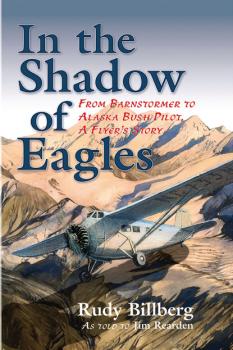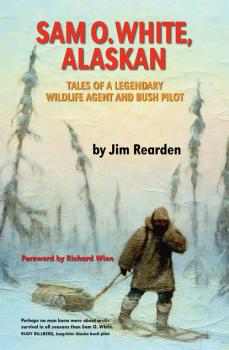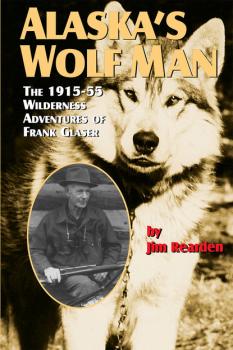ТОП просматриваемых книг сайта:
Jim Rearden
Список книг автора Jim ReardenАннотация
In the Shadow of Eagles is a uniquely American saga. Rudy Billberg’s story takes readers through the great age of aviation, from his first airplane ride in Minnesota in 1927 to his bush flying career in Alaska beginning in 1941. One of the authentic aviation pioneers, Billberg writes of his countless adventures and close calls during the decades; stunt flying in Midwestern air shows, flying out of Nome into the frozen Arctic, and more. Filled with history and insight, Billberg’s narrative chronicles the lives of many of his fellow Alaskan pilots, including the great pioneer airmen Joe Crosson, Harold Gillam, Noel Wien and Sam White, and tells of the early flying machines they all flew—Travel Airs, Pilgrims, Fairchilds, Bellancas. Rudy Billberg has given us a great story of his time.
Аннотация
“I owe Alaska. It gave me everything I have.” Says Sidney Huntington, son of an Athapaskan mother and white trader/trapper father. Growing up on the Koyukuk River in Alaska’s harsh Interior, that “everything” spans 78 years of tragedies and adventures. When his mother died suddenly, 5-year-old Huntington protected and cared for his younger brother and sister during two weeks of isolation. Later, as a teenager, he plied the wilderness traplines with his father, nearly freezing to death several times. One spring, he watched an ice-filled breakup flood sweep his family’s cabin and belongings away. These and many other episodes are the compelling background for the story of a man who learned the lessons of a land and culture, lessons that enabled him to prosper as trapper, boat builder, and fisherman. This is more than one man's incredible tale of hardship and success in Alaska. It is also a tribute to the Athapaskan traditions and spiritual beliefs that enabled him and his ancestors to survive. His story, simply told, is a testament to the durability of Alaska's wild lands and to the strength of the people who inhabit them.
Аннотация
Jim Rearden is Alaska's most popular outdoors journalist. He holds two degrees in wildlife management and was Professor of Wildlife Management at the University of Alaska Fairbanks 1950-54. As a member of the Alaska Board of Game 75-82 he helped develop the Tanana Flats wolf control program. He details with historical accuracy the controversy that erupted when the 1975 program was announced. Counterpointing the modern controversy, Rearden includes exciting segments of his best-selling Alaska's Wolf Man, the story of Frank Glaser, Alaska's full-time government wolf hunter who hunted wolves in the Territory of Alaska 1915-1955. Alaska’s wolves are the main characters in this historically and biologically accurate recounting. Included are vivid anecdotes about wolves with descriptions of their behavior and way of life, examples of their intelligence, and expressions of appreciation for their charm and beauty, as well as an honest look at their savage efficiency as predators and relationship to urban and rural Alaskans.
Аннотация
Sam O. White was a tough, deep-voiced, six-foot-tall, two-hundred-pound former Maine lumberjack and guide. From 1922, for half a century he criss-crossed wild Alaska by foot, with packhorses, dog teams, canoe, riverboat, and airplane. He helped map the Territory. He trapped fur. He became the world’s first flying game warden. White wrote exciting tales about his Alaska adventures. Those writings make up the bulk of this volume. In 1927, he arrived at Fort Yukon as a game warden when millions of dollars worth of fine arctic furs annually arrived there. The hardy frontier trappers considered the new game warden a joke, but he quickly taught them to respect conservation laws. He was frustrated by the impossibility of adequately patrolling thousands of square miles by dog team, boat, and on foot. With his own money he bought an airplane. Pioneer pilots Noel and Ralph Wien taught him how to fly it. White then startled remote trappers and others by suddenly arriving from the sky. In 1941, lack of backing from Juneau headquarters caused him to resign as a wildlife agent. At Fairbanks, Noel Wien made him Chief Pilot for Wien Airlines. For the next two decades White flew as an Alaskan bush pilot, admired for his flying skill and the superior service he provided residents who flew with him, and who depended upon him for receiving mail and supplies. He had countless friends—one hundred arrived for his seventieth birthday party. His integrity and principles were of the highest. Decades after his death, he is still spoken of with awe by he lings-time Alaskans. White write exciting takes about his Alaska adventures. Those writings make up the bulk of this volume.
Аннотация
Between 1915 and 1955 adventure-seeking Frank Glaser, a latter-day Far North Mountain Man, trekked across wilderness Alaska on foot, by wolf-dog team, and eventually, by airplane. In his career he was a market hunter, trapper, roadhouse owner, professional dog team musher, and a federal predator control agent. A naturalist at heart, he learned from personal observation life secrets of moose, caribou, foxes, wolverine, Dall sheep, grizzly bears, and wolves—especially wolves. A superb shot, self-sufficient, and wilderness wise, Glaser not only survived, but prospered in the far lonely places. Almost always alone, he survived many encounters with charging grizzly bears, some of which he had to shoot to keep from being mauled. He knew how to cope with 50 and 60 below zero temperatures, and more than once he plunged through the ice in extreme cold and survived only because of his woods know-how.
Аннотация
This book follows the careers of Alaska's pioneering pilots, who, with cranky open-cockpit biplanes, started the great change in Alaska's way of travel. Aviation first arrived at Fairbanks, the trade center of mainland Alaska, from which dog sled trails spider-web to mines, villages, and trap-lines. During winters, goods and people traveled mostly by dog sled. During the summer of 1923 Ben Eielson was the first to fly commercially from Fairbanks, ferrying passengers and light freight with an open cockpit Jenny (JN4) biplane. It was the beginning of the leap from ground travel to the air. Noel Wien was the next. In the summers of 1924-26 he flew open cockpit biplanes from Fairbanks. Starting in 1927, he flew a cabin biplane year-around on scheduled flights in the 579 miles between Fairbanks and Nome. In March, 1929, Wien flew from Alaska to the Elisif, an ice-locked trading schooner in Siberia, to return with a load of valuable furs. In the following November, Ben Eielson repeated this flight to the Nanuk, another ice-bound trading schooner in Siberia. And when he and his mechanic, Earl Borland returned for a second load of Siberian fur, their Hamilton airplane disappeared in a winter snowstorm. This brought on one of the most famous, and difficult aerial searches ever made from and in Alaska. By the 1930s, Alaska's growing aviation industry had revolutionized transportation in the Territory. This volume is a fond look back at the triumphs and tragedies of the pioneering Ben Eielson, Noel Wien, Harold Gillam, Joe Crosson, Ed Young, and others, the great pilots who were the first bush pilots of Alaska.







